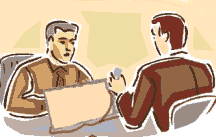
|
Appendix: [Home] [Index/Search] [No frame] [Tech terms] [Scales] [Axioms] [Drills] [Ethics] |
|
[Checksheets] [Processes] [Prep. lists] [C/S terms] [C/S tool] [Grades] [Cramm] [Points] [KTW] |
[Cramming] [Pink Sheet] [Important Study Data]
Cramming

|
This short chapter does not attempt to give all the information needed to run a Cramming Section, but gives enough data to make students and practitioners (here called clients) aware of how it works and how to use it. Cramming Cramming Order
Cramming Interview Cramming Assignment Doing the Assignment
When the cramming assignment is completed the client attests the difficulty is handled. He then goes back to course or to do auditing or to practice his trade. The real difference between a Pink Sheet and a Cramming Assignment is, that the Cramming Assignment is based on the interview and the trouble-shooting. Cramming is only done with clients if a Pink Sheet didn't handle the difficulty. It's assumed it is time to dig deeper, using a Meter.
Retread
Retraining Rusty Practitioners On-the-Job-Training
|
|
Appendix: [Home] [Index/Search] [No frame] [Tech terms] [Scales] [Axioms] [Drills] |
|
[Checksheets] [Processes] [Prep. lists] [C/S terms] [C/S tool] [Grades] [Cramm] [Points] [KTW] |
[Cramming] [Pink Sheet] [Important Study Data]
Pink Sheets

Definition: A Pink Sheet is a study assignment given to a student when he has missed something he should have learned earlier. It calls for restudy and check-out of the specific materials he missed. It is called a Pink Sheet because it is written on a pink sheet of paper.
The gap between learning some data and demonstrating practical skills in the subject takes several huge steps to cross. The Pink Sheet system in training helps the student do that. Getting Pink Sheets as a student, seeing what he did wrong and restudying that, sharpens his ability to apply Study Technology, to himself and to his twin, as well.
The student is responsible for all the materials and courses he has studied earlier. If he is unable to apply or use any of these materials the supervisor can issue a Pink Sheet and have the student catch up on anything missed. A Pink Sheet should never develop into a long action. It is a quick and precise remedy to correct the student and get him back on track.
The Supervisor observes
or examines the student.
He writes his observations
and corrects anything found
to be out with a Pink Sheet.The course supervisor has a clip board with Pink Sheet forms on it. He issues one of these when he sees the student apparently has missed something. This can be as a result of a drill that causes trouble, any weak materials revealed by a check-out, or an examination. The supervisor can also do direct observations of students' study habits or general behavior and issue a Pink Sheet based on his observations.
Writing a Pink Sheet
The supervisor has, as mentioned, a clip board with pink sheet forms on it.1. He always makes a carbon copy of any pink sheet he issues. He simply puts a sheet of carbon paper between two forms and writes on the top and gets a copy underneath for his own use.
2. He writes the name of the student or coach being observed, the date, and his own name at top of the form.
Date:
Student: Observer: Sup: Coach: Assignment: Observations:
3. There is a wide column at the right of the sheet called "observations". A narrower column to the left of that headlined, "Theory and Practical Assignment" or simply "Assignment", and two more columns to the left headed "Coach" and "Supervisor".
4. The supervisor observes the student or a coaching session, standing close enough to hear and see what is going on.
5. He writes his observations in the column "Observations" exactly as observed; it can be a coaching session or an individual student studying or applying what is learned.
He does not necessarily look for study- and coaching-errors at first. He just looks and records what is happening. He does not write opinions or evaluations - nor invalidations. He does not attempt to correct or teach in the "Observations" column. He simply observes the activity and records what is happening. It may result in no assignment at this point. He is just making his presence and interest in what is going on felt.
6. He may write one or more pages of "Observations" in that column. Now it is time to evaluate. He looks over what he has noted to and sees if anything actually needs correction.
7. If he has found something he fills in "Assignment" with a theory and/or practical assignment. He writes down the exact materials from the course materials to be studied. The chapter, drill, or bulletin which contain the correct data or drill needed to correct the errors observed.
If he can't pinpoint the main difficulty, he may ask the student a few questions. Some of the answers he gets can be quite surprising. He finds the main error or difficulty and writes the Pink Sheet to get the student corrected.
Sometimes the supervisor can write several pages of "Observations" without recording any errors. The student is doing it right or the coaching drill is going well; Study Technology is being used correctly. That's fine - the Pink Sheet can still be given to the student without any assignment. It will still help the student.
8. The original of the Pink Sheet is given to the student. The copy is kept by the supervisor as a control copy. When the student hands in the completed original, with all the necessary things done and signed off, the carbon copy is simply thrown away. The completed Pink Sheet is filed in the student's study file.
Doing the Assignment
When a student has gotten a Pink Sheet assignment it should be done with a twin, whether it is theory, practical, or both. The twin first reviews the observations with the student. Then he or she star-rates the student on the issues as assigned and drills the student until the correct data are completely learned and understood or the student can do the drills correctly.Once this is done the twin signs his name or initials in the coach's column. The student is then ready for a check-out by the supervisor on the Pink Sheet material.
Supervisor Check-out
The student now turns his Pink Sheet in to the supervisor. This is done in person as the supervisor may want to go over it with the student and do a check-out of his own. He wants to know if it has handled what was observed or if he has to keep a close eye on the student or give him additional assignments.Summary
Pink Sheets are never used as punishment or to make the student wrong. They are used to improve the student's study- or coaching-ability by having him re-study data and do practical drills in the weak areas.A student's weaknesses in data and skills will often not show up under the normal conditions of theory study and practical drilling, but they will stand out very plainly when he has to apply them in an actual situation. Therefore, a Pink Sheet Assignment does not necessarily mean that the student didn't study the material properly, even if he has already passed it in Theory or Practical. It does mean that he hasn't learned it well enough to use it under the duress of an actual situation. If a student has gone a few days without receiving a Pink Sheet, he should start demanding one. Pink Sheets ensure one basic point of the Study Technology is at work: you want study to result in a string of certainties. This may take several or many times over the materials to be able to do things correctly under trying conditions in practice.
Appendix: [Home] [Index/Search] [No frame] [Tech terms] [Scales] [Axioms] [Drills]
[Checksheets] [Processes] [Prep. lists] [C/S terms] [C/S tool] [Grades] [Cramm] [Points] [KTW]
[Cramming] [Pink Sheet] [Important Study Data]
Important Study Data
1. Number of times over the material equal certainty and results.2. Results in the student's own case is a guarantee of successful application by the student.
1. When we talk about practical application you can't expect the student to get all the fine points just by studying the theory. No matter how thoroughly he studies, the practical experience of handling all kinds of situations will be missing. Thus, the only way to become a professional consists of studying the materials, apply the materials, study the materials again, apply the materials some more. Then catch up on the finer points of application that were missed. This is done by studying selected sections of theory and apply it to practical problems and situations. Based on that the student will now gain a new and practical oriented understanding. This is only accomplished by going over the materials many, many times - and each time relate it to new practical experiences in the field.
2. The personal experience of receiving a service you study is important. When the student has a subjective reality on how a technology works he can apply it to others with success. This is especially true for auditing where you produce increased awareness and ability. A student who has successfully received auditing and experienced the benefits is much more likely to be able to audit others successfully.
|
Home Search Level 0 Level 1 Level 2 Level 3 Level 4 Level 4Pro Level 5 C/Sing Solo |
|
|
| Tech terms | Scales | Axioms | Drills | Checksheets | Processes | Prep. lists | C/S terms | C/S tool | Grades | Cramm | Points | KTW | Online | |